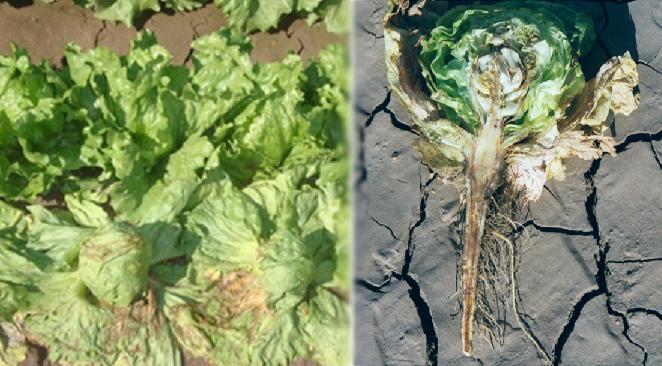 |
|
|
|

|
|||
| |
|||
With the beginning of another lettuce growing season in Arizona comes the threat of diseases caused by soil-borne fungal pathogens. Diseases of concern for lettuce now being planted include Fusarium wilt, Sclerotinia drop, and bottom rot. Symptoms of Fusarium wilt, caused by Fusarium oxysporum f. sp. lactucae, can appear on lettuce anytime after thinning. There are no effective fungicides that can be used to manage Fusarium wilt. This disease is best avoided by not planting susceptible types of lettuce (virtually all head lettuce varieties) in ground known to contain the pathogen, especially during September or October. Soil temperatures during these months favor the growth of Fusarium oxysporum and the resulting development of the wilt disease. Sclerotinia drop and bottom rot usually do not become apparent in fields until plants are at or past the rosette stage of development. Successful management of Sclerotinia drop, caused almost exclusively by Sclerotinia minor on lettuce that will be harvested in November and December, as well as bottom rot caused by Rhizoctonia solani, require application of fungicides well before the appearance of disease symptoms. Sclerotinia minor and Rhizoctonia solani exist in soil as resistant structures called sclerotia. Successful management of diseases caused by these pathogens is closely tied to prevention of germination of these sclerotia; therefore, applications of fungicides are made to the soil, where the sclerotia are found. Early application of fungicides, when plants are very small, facilitates thorough coverage of the bed surface. As plants develop and cover increasing amounts of the bed surface, fungicide coverage of soil and disease control decline. Sclerotinia and Fusarium Symptoms To contact Mike Matheron go to: matheron@ag.arizona.edu.
|
|||
| Back | |||
For questions or comments on any of the topics please contact Marco Pena at the Yuma Agricultural Center. |
|||
| Home | Cotton
| Veggies | Forages
| Grains | Citrus
| Crop x Crop Insects | Diseases| Weeds | Pesticides | Economics | News | Weather | Research | Photos | Contacts | General Info. Copyright © 2001 University of Arizona, College of Agriculture and Life Sciences Webmaster: Al Fournier (acis@ag.arizona.edu) |
|||
